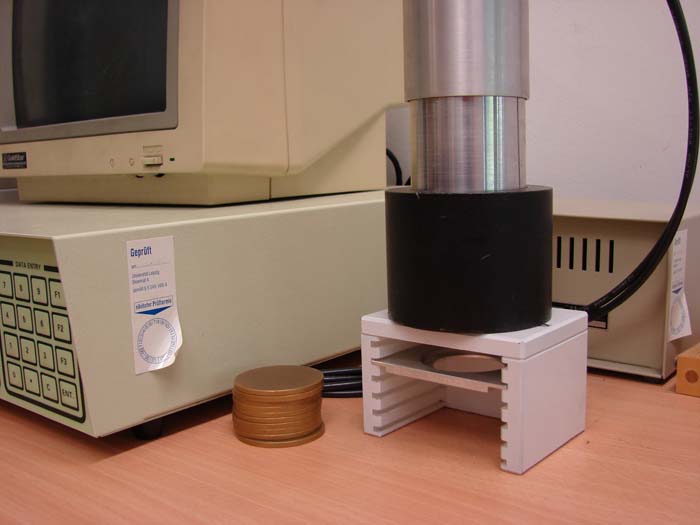ASTM C1672 Gamma Spectrometry of Cesium-137 in Waste
The ASTM C1672 standard provides a method for determining the concentration of Cs-137 in waste materials using gamma spectroscopy. This service is highly relevant to sectors such as environmental testing, hazardous waste management, and nuclear facilities. The primary goal is not only to ensure regulatory compliance but also to provide accurate data that can inform decisions about waste storage, treatment, and disposal.
Gamma spectrometry involves the measurement of gamma radiation emitted by radioactive isotopes. In this case, Cs-137 is a significant concern because it has a long half-life (about 30 years) and produces penetrating gamma rays. The ASTM C1672 method focuses on quantifying the amount of Cs-137 present in waste materials, which is crucial for assessing the radiological hazard and determining appropriate handling procedures.
The testing process begins with the collection and preparation of a representative sample from the waste material. The sample must be stable and free from contamination that could affect the measurement results. Once prepared, the sample is placed in the gamma spectrometer, which detects the gamma radiation emitted by Cs-137. The instrument measures the intensity of this radiation and compares it to known standards.
The accuracy and reliability of ASTM C1672 depend on several factors, including the quality of the sample preparation, the calibration of the spectrometer, and the precision of the measurement techniques used. Proper calibration ensures that the instrument can accurately differentiate between different isotopes and their respective energies. The precision of the measurements is critical for ensuring that the results are repeatable and reproducible.
The ASTM C1672 method uses a high-purity germanium (HPGe) detector, which is sensitive to gamma radiation. The HPGe detector is placed in close proximity to the sample, allowing it to capture as much of the emitted radiation as possible. This setup ensures that even small amounts of Cs-137 can be detected and measured accurately.
The results from ASTM C1672 are typically reported as the activity concentration of Cs-137 in the waste material. The units used for reporting are usually Becquerels per kilogram (Bq/kg) or Curie per metric tonne (Ci/t). These values provide critical information about the radiological hazard associated with the waste and help determine appropriate handling procedures.
The ASTM C1672 method is widely accepted in regulatory contexts, particularly for nuclear facilities and hazardous waste management. Regulatory bodies such as the International Atomic Energy Agency (IAEA), European Commission (EC), and various national standards organizations recognize this standard. Its use ensures that all parties involved are working to a consistent methodology.
The ASTM C1672 method is applicable not only in the United States but also internationally. Many countries with nuclear facilities or significant amounts of radioactive waste rely on this standard for their testing needs. This international acceptance underscores its importance and reliability as a global reference.
Understanding the specific parameters and requirements outlined in ASTM C1672 helps ensure that the testing process is conducted correctly and consistently. The standard specifies detailed procedures for sample preparation, instrument calibration, data acquisition, and reporting. Compliance with these guidelines ensures accurate and reliable results.
Applied Standards
| Standard Name | Description |
|---|---|
| ASTM C1672 | Method for Determining the Concentration of Cesium-137 in Waste by Gamma Spectrometry. |
| ISO 15008:2009 | Guidelines for Quality Management Systems in Testing and Calibration Laboratories. |
| IEC 61526-1 | Data Transmission Protocol for Gamma Spectrometers. |
The ASTM C1672 standard is the primary applied standard for this service. It provides detailed procedures and guidelines for conducting gamma spectroscopy on waste materials to determine Cs-137 concentrations. Compliance with this standard ensures that all testing processes are accurate, reliable, and repeatable.
Other relevant standards include ISO 15008:2009, which outlines quality management systems in testing and calibration laboratories. This standard helps ensure the overall reliability of the testing process by providing best practices for laboratory operations. Additionally, IEC 61526-1 specifies data transmission protocols for gamma spectrometers, ensuring that data from the instrument can be accurately and reliably transmitted to the testing facility.
International Acceptance and Recognition
The ASTM C1672 method is widely recognized and accepted internationally. Many countries with nuclear facilities or significant amounts of radioactive waste rely on this standard for their testing needs. Regulatory bodies such as the International Atomic Energy Agency (IAEA) and various national standards organizations recognize its importance.
International acceptance of ASTM C1672 is due in part to its rigorous methodology and consistent results across different laboratories. The standard's widespread use ensures that all parties involved are working to a common, reliable reference. This international recognition also facilitates cooperation between countries on nuclear safety and waste management issues.
The standard's reliability is further enhanced by the involvement of experts from various countries in its development and maintenance. This global collaboration ensures that the standard remains relevant and applicable to diverse testing environments. The ASTM C1672 method is a testament to the international community's commitment to nuclear safety and environmental protection.
Use Cases and Application Examples
| Use Case | Description |
|---|---|
| Nuclear Power Plants | Determining the Cs-137 concentration in spent fuel to assess radiological risk. |
| Hazardous Waste Management Facilities | Monitoring waste streams for compliance with regulatory limits on Cs-137 content. |
| Nuclear Research Laboratories | Analyzing radioactive samples from experiments involving Cs-137. |
The ASTM C1672 method has several key use cases and application examples across various industries. In nuclear power plants, the method is used to determine the concentration of Cs-137 in spent fuel, which helps assess radiological risk and ensure compliance with safety regulations.
In hazardous waste management facilities, the ASTM C1672 method is used to monitor waste streams for compliance with regulatory limits on Cs-137 content. This ensures that all waste materials are handled safely and legally, reducing the risk of environmental contamination.
Nuclear research laboratories also use the ASTM C1672 method to analyze radioactive samples from experiments involving Cs-137. This helps researchers understand the behavior of this isotope under different conditions and develop safer handling procedures.





